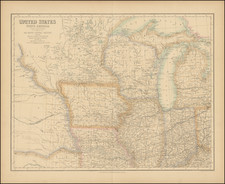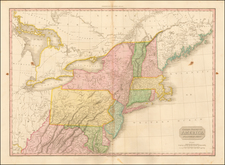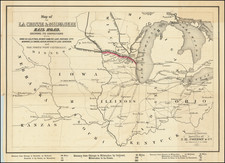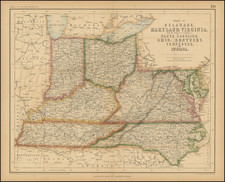A collection of 11 finely-drafted pencil sketches of towns and scenes from a trip to the Midwest shortly after the U.S. Civil War.
This beautifully drafted series of pencil sketches documents a trip down the Missouri River and then up the Ohio River, around 1870, during the Golden Age of American commerce in the midwest. In the years following the Civil War (1861-5), the river regions of the midwest experienced a great flourishing of commercial activity and population growth. Cities such as Cincinnati played a leading role in America's Industrial Revolution, while Omaha, Nebraska and St. Joseph, Missouri acted as the gateways to the 'Wild West'. At the time, the rivers hosted great symbols of modernity (ex. steamships, great bridges and factories) juxtaposed against traditional aspects of American life (logboats, carriages and log cabins).
The Ohio-Missouri corridor had long been a favored route for artists and writers seeking to capture quintessential American scenes. While the artist of the present sketches remains anonymous, he evidently had received formal training in draftsmanship, as the technical élan of drawings is impressive. Taken together, this set of drawings represent an original, unvarnished, yet highly competent depiction of the midwest at its historical apogee.
The sketches are ordered roughly along the assumed direction of the artist's travel (west to east), and include:
1. "Omaha City, Nbr."
A fine view of the burgeoning city of Omaha, Nebraska, near the confluence of the Platte and Missouri rivers. During the 1870s, Omaha was the main gateway to the American West, as it was the eastern terminus of the Union Pacific Railroad, completed in 1869, the first fixed link to the Pacific.
2. "St. Joseph, Missouri River".
St. Joseph was long known as the "Jumping-Off Point" to the "Wild West". A busy port on the Missouri River, until just after the Civil War, it was the westernmost point reachable by rail. From 1860 to 1861, St. Joseph was famously the eastern terminus of the 'Pony Express', carrying letters to and from California.
3. "On the Missouri near St. Joseph".
A bucolic scene looking down from high, forested bluffs to the Missouri River, featuring a steam boat.
4. "Lafayette Park, St. Louis".
This fine picture shows the old bridge at Lafayette Park in St. Louis. Founded in 1838, the park was the oldest landscaped green space in the city. It was at Lafayette Park, in 1870, that Carl Daenzer introduced the Eurasian Tree Sparrow to North America, today one of the continent's most prolific species.
5. "Entrance to Shaw's Botanical Garden, St. Louis, Mo".
Shaw's Botanical Garden (today known as the Missouri Botanical Garden) was founded in 1859 in St. Louis by the philanthropist Henry Shaw, making it one of the oldest botanical gardens in the United States. Occupying 79 acres, it contained a number of elaborately landscaped constructions, and featured this fine neoclassical gateway.
6. "On the Ohio River".
A lovely view featuring a logboat travelling down a rural stretch of the Ohio River, with a log cabin along the riverbank. It reminds the modern viewer of a scene from Mark Twain's Huckleberry Finn (1884).
7. "At Louisville, Ky".
A street scene in Louisville, Kentucky's main city, of a man with a horse-drawn cart carry barrels (perhaps of bourbon!) with townhouses in the background.
8. "Ohio River, near Louisville".
This evocative American scene shows paddle wheelers and log boats on the Ohio River near Louisville, Kentucky.
9. [Bethlehem, Kentucky] "Bethlehem Near Cincinnati".
This view shows the village of Bethlehem, in Henry County, Kentucky, not far south of the Ohio River.
10. "Cincinnati / Ohio River / Covington".
In the 1870s, Cincinnati, with a population around 250,000, was one of the largest and most vibrant cities in America. It was the preeminent port on the Ohio River and a major nexus between the Northern and Southern states. In the foreground are the numerous factories that made Cincinnati a lynchpin of the Industrial Age, and in the background is the John A. Roebling Bridge, completed in 1867, it was a marvel of engineering. With a main span of 1,057 feet, it was then the worlds' longest suspension bridge.
11. "Near Cincinnati"
A fine view of a rural mill near Cincinnati, Ohio.










![[ Great Lakes - Upper Midwest -- Western Canada ] Partie Occidentale Du Canada, contenant les cinq Grands Lacs, avec Pays Circonvoisons](https://storage.googleapis.com/raremaps/img/small/98377.jpg)

![A Map of Lewis and Clark's Track Across the Western Portion of North America, from the Mississippi to the Pacific Ocean. By Order of the Executive of the United States in 1804, 5 & 6. . . . [Complete with 3 volumes of Text: Travels to the Source of the Missouri River and Across the American Continent to the Pacific Ocean. Performed by Order of the Government of the United States, in the Years 1804, 1805, and 1806].](https://storage.googleapis.com/raremaps/img/small/81775.jpg)

